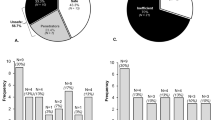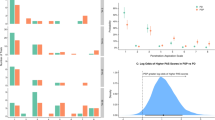Abstract
The purpose of this retrospective study was to determine whether reduced lingual strength was associated with functional swallowing outcomes in individuals with Parkinson’s disease (PD). Participants (N = 42) completed evaluations of maximal lingual isometric pressure (MIP) and mean lingual swallowing pressure (MSP), and flexible endoscopic evaluations of swallowing. Regression models were used to determine the association between lingual strength and functional swallowing outcomes of airway invasion, the presence of post-swallow pharyngeal residue, and the amount of pharyngeal residue (when present). Results revealed that higher MIP (p = 0.002, OR 0.93) and higher MSP (p = 0.001 OR 0.88) were associated with less airway invasion of thin liquids. Both MIP and MSP were able to differentiate between those with and without dysphagia (MIP: AUC 0.7935, p = 0.001; MSP: AUC 0.75, p = 0.026). Neither MIP nor MSP was related to the presence of residue. However, when thin liquid oropharyngeal residue was present, both MIP (p < 0.001, OR 0.99) and MSP (p < 0.001; OR 0.98) were significantly associated with the amount of residue observed. Similarly, when thin liquid hypopharyngeal residue was present, MIP (p < 0.001, OR 0.99) and MSP (p < 0.001, OR 0.98) were associated with the amount of residue observed. These findings suggest a relationship between reduced lingual strength and worse thin liquid swallowing safety and efficiency; however, the magnitude of these effects was small. This indicates that lingual strength is one important contributing factor to functional swallowing impairments in PD and may identify those with unsafe swallowing. These findings have important clinical implications for including lingual strength in the screening, assessment, and management of dysphagia in PD.





Similar content being viewed by others
References
Kalf JG, de Swart BJM, Bloem BR, Munneke M. Prevalence of oropharyngeal dysphagia in Parkinson’s disease: a meta-analysis. Parkinsonism Relat Disord. 2012;18:311–5. https://doi.org/10.1016/j.parkreldis.2011.11.006.
Potulska A, Friedman A, Królicki L, Spychala A. Swallowing disorders in Parkinson’s disease. Parkinsonism Relat Disord. 2003;9:349–53. https://doi.org/10.1016/S1353-8020(03)00045-2.
Miller N, Noble E, Jones D, Burn D. Hard to swallow: dysphagia in Parkinson’s disease. Age Ageing. 2006;35:614–8. https://doi.org/10.1093/ageing/afl105.
Leow LP, Huckabee M-L, Anderson T, Beckert L. The impact of dysphagia on quality of life in ageing and Parkinson’s disease as measured by the swallowing quality of life (SWAL-QOL) questionnaire. Dysphagia. 2010;25:216–20. https://doi.org/10.1007/s00455-009-9245-9.
Fernandez HH, Lapane KL. Predictors of mortality among nursing home residents with a diagnosis of Parkinson’s disease. Med Sci Monit. 2002;8:CR241–6.
Fei T, Polacco RC, Hori SE, Molfenter SM, Peladeau-Pigeon M, Tsang C, et al. Age-related differences in tongue-palate pressures for strength and swallowing tasks. Dysphagia. 2013;28:575–81. https://doi.org/10.1007/s00455-013-9469-6.
Namasivayam-MacDonald AM, Morrison JM, Steele CM, Keller H. How swallow pressures and dysphagia affect malnutrition and mealtime outcomes in long-term care. Dysphagia. 2017;32:785–96. https://doi.org/10.1007/s00455-017-9825-z.
Argolo N, Sampaio M, Pinho P, Melo A, Nóbrega AC. Videofluoroscopic predictors of penetration-aspiration in Parkinson’s disease patients. Dysphagia. 2015;30:751–8. https://doi.org/10.1007/s00455-015-9653-y.
Umemoto G, Tsuboi Y, Kitashima A, Furuya H, Kikuta T. Impaired food transportation in Parkinson’s disease related to lingual bradykinesia. Dysphagia. 2011;26:250–5. https://doi.org/10.1007/s00455-010-9296-y.
Nagaya M, Kachi T, Yamada T, Igata A. Videofluorographic study of swallowing in Parkinson’s disease. Dysphagia. 1998;13:95–100. https://doi.org/10.1007/PL00009562.
Bird MR, Woodward MC, Gibson EM, Phyland DJ, Fonda D. Asymptomatic swallowing disorders in elderly patients with Parkinson’s disease: a description of findings on clinical examination and videofluoroscopy in sixteen patients. Age Ageing. 1994;23:251–4. https://doi.org/10.1093/ageing/23.3.251.
Butler SG, Stuart A, Leng X, Wilhelm E, Rees C, Williamson J, et al. The relationship of aspiration status with tongue and handgrip strength in healthy older adults. J Gerontol Ser A. 2011;66A:452–8. https://doi.org/10.1093/gerona/glq234.
Steele CM, Cichero JAY. Physiological factors related to aspiration risk: a systematic review. Dysphagia. 2014;29:295–304. https://doi.org/10.1007/s00455-014-9516-y.
Curtis JA, Laus J, Schneider SL, Troche MS. Examining the relationships between lingual strength, perihyoid strength, and swallowing kinematics in dysphagic adults: a retrospective cross-sectional analysis. J Speech Lang Hear Res. 2021;64:405–16. https://doi.org/10.1044/2020_JSLHR-20-00143.
Printza A, Boziki M, Triaridis S, Kiousi V, Arnaoutoglou M, Constantinidis J, et al. Tongue strength, dysphagia questionnaire, pharyngeal secretions and FEES findings in dysphagia management in amyotrophic lateral sclerosis. Auris Nasus Larynx. 2021;48:672–82. https://doi.org/10.1016/j.anl.2020.10.007.
Velasco LC, Imamura R, Rêgo APV, Alves PR, da Silva Peixoto LP, de Oliveira SJ. Sensitivity and specificity of bedside screening tests for detection of aspiration in patients admitted to a public rehabilitation hospital. Dysphagia. 2021;36:821–30. https://doi.org/10.1007/s00455-020-10198-9.
Clark H, Henson P, Barber W, Stierwalt J, Sherrill M. Relationships among subjective and objective measures of tongue strength and oral phase swallowing impairments. Am J Speech-Lang Pathol. 2003;12:40–50. https://doi.org/10.1044/1058-0360(2003/051).
Smaoui S, Langridge A, Steele CM. The effect of lingual resistance training interventions on adult swallow function: a systematic review. Dysphagia. 2020;35:745–61. https://doi.org/10.1007/s00455-019-10066-1.
McKenna VS, Zhang B, Haines MB, Kelchner LN. A systematic review of isometric lingual strength-training programs in adults with and without dysphagia. Am J Speech Lang Pathol. 2017;26:524–39. https://doi.org/10.1044/2016_AJSLP-15-0051.
Jenks J, Pitts LL. Effects of an intensive exercise-based swallowing program for persons with Parkinson’s disease and complex medical history: a single-case experiment. Am J Speech Lang Pathol. 2019;28:1268–74. https://doi.org/10.1044/2019_AJSLP-18-0168.
Oommen ER, Cuellar ME, Scholten A, Rylander B, David M. Objective measures of lingual and jaw function in healthy adults and persons with Parkinson’s disease: implications for swallowing. Physiol Behav. 2021;232: 113349. https://doi.org/10.1016/j.physbeh.2021.113349.
McAuliffe MJ, Ward EC, Murdoch BE, Farrell AM. A nonspeech investigation of tongue function in Parkinson’s disease. J Gerontol Ser A. 2005;60:667–74. https://doi.org/10.1093/gerona/60.5.667.
Solomon NP, Robin DA, Luschei ES. Strength, endurance, and stability of the tongue and hand in Parkinson disease. J Speech Lang Hear Res. 2000;43:256–67. https://doi.org/10.1044/jslhr.4301.256.
Gandhi P, Plowman EK, Steele CM. Comparison of lingual pressure generation capacity in Parkinson disease, amyotrophic lateral sclerosis, and healthy aging. Am J Speech Lang Pathol. 2022;31:1845–53. https://doi.org/10.1044/2022_AJSLP-21-00385.
Pitts LL, Cox A, Morales S, Tiffany H. A systematic review and meta-analysis of iowa oral performance instrument measures in persons with Parkinson’s disease compared to healthy adults. Dysphagia. 2021. https://doi.org/10.1007/s00455-021-10254-y.
Pitts LL, Morales S, Stierwalt JAG. Lingual pressure as a clinical indicator of swallowing function in Parkinson’s disease. J Speech Lang Hear Res. 2018;61:257–65. https://doi.org/10.1044/2017_JSLHR-S-17-0259.
O’Day C, Frank E, Montgomery A, Nichols M, McDade H. Repeated tongue and hand strength measurements in normal adults and individuals with Parkinson’s disease. Int J Orofac Myol. 2005;31:15–25.
Pitts LL, Kanadet RM, Hamilton VK, Crimmins SK, Cherney LR. Lingual pressure dysfunction contributes to reduced swallowing-related quality of life in Parkinson’s DISEASE. J Speech Lang Hear Res. 2019;62:2671–9. https://doi.org/10.1044/2019_JSLHR-S-18-0366.
Minagi Y, Ono T, Hori K, Fujiwara S, Tokuda Y, Murakami K, et al. Relationships between dysphagia and tongue pressure during swallowing in Parkinson’s disease patients. J Oral Rehabil. 2018;45:459–66. https://doi.org/10.1111/joor.12626.
Fukuoka T, Ono T, Hori K, Wada Y, Uchiyama Y, Kasama S, et al. Tongue pressure measurement and videofluoroscopic study of swallowing in patients with Parkinson’s disease. Dysphagia. 2019;34:80–8. https://doi.org/10.1007/s00455-018-9916-5.
Pisegna JM, Langmore SE. Parameters of instrumental swallowing evaluations: describing a diagnostic dilemma. Dysphagia. 2016;31:462–72. https://doi.org/10.1007/s00455-016-9700-3.
Fattori B, Giusti P, Mancini V, Grosso M, Barillari MR, Bastiani L, et al. Comparison between videofluoroscopy, fiberoptic endoscopy and scintigraphy for diagnosis of oro-pharyngeal dysphagia. Acta Otorhinolaryngol Ital. 2016;36:395–402. https://doi.org/10.14639/0392-100X-829.
Kelly AM, Drinnan MJ, Leslie P. Assessing penetration and aspiration: how do videofluoroscopy and fiberoptic endoscopic evaluation of swallowing compare? Laryngoscope. 2007;117:1723–7. https://doi.org/10.1097/MLG.0b013e318123ee6a.
Kelly AM, Leslie P, Beale T, Payten C, Drinnan MJ. Fibreoptic endoscopic evaluation of swallowing and videofluoroscopy: does examination type influence perception of pharyngeal residue severity? Clin Otolaryngol. 2006;31:425–32. https://doi.org/10.1111/j.1749-4486.2006.01292.x.
Daniel SE, Lees AJ. Parkinson’s Disease Society Brain Bank, London: overview and research. J Neural Transm Suppl. 1993;39:165–72.
Adams V, Mathisen B, Baines S, Lazarus C, Callister R. A systematic review and meta-analysis of measurements of tongue and hand strength and endurance using the Iowa Oral Performance Instrument (IOPI). Dysphagia. 2013;28:350–69. https://doi.org/10.1007/s00455-013-9451-3.
Curtis JA, Borders JC, Perry SE, Dakin AE, Seikaly ZN, Troche MS. Visual analysis of swallowing efficiency and safety (VASES): a standardized approach to rating pharyngeal residue, penetration, and aspiration during FEES. Dysphagia. 2021. https://doi.org/10.1007/s00455-021-10293-5.
Rosenbek JC, Robbins JA, Roecker EB, Coyle JL, Wood JL. A penetration-aspiration scale. Dysphagia. 1996;11:93–8. https://doi.org/10.1007/BF00417897.
Copay AG, Subach BR, Glassman SD, Polly DW, Schuler TC. Understanding the minimum clinically important difference: a review of concepts and methods. Spine J. 2007;7:541–6. https://doi.org/10.1016/j.spinee.2007.01.008.
Rubin M. When to adjust alpha during multiple testing: a consideration of disjunction, conjunction, and individual testing. Synthese. 2021;199:10969–1000. https://doi.org/10.1007/s11229-021-03276-4.
R Core Team. R: a language and environment for statistical computing. Vienna, Austria: R Foundation for Statistical Computing; 2018.
IOPI Medical. IOPI Medical n.d. https://iopimedical.com/normal-values/.
Carter JV, Pan J, Rai SN, Galandiuk S. ROC-ing along: evaluation and interpretation of receiver operating characteristic curves. Surgery. 2016;159:1638–45. https://doi.org/10.1016/j.surg.2015.12.029.
Cai Y, Feng F, Wei Q, Jiang Z, Ou R, Shang H. Sarcopenia in patients with Parkinson’s disease: a systematic review and meta-analysis. Front Neurol. 2021;12:111.
Maeda K, Akagi J. Sarcopenia is an independent risk factor of dysphagia in hospitalized older people. Geriatr Gerontol Int. 2016;16:515–21. https://doi.org/10.1111/ggi.12486.
Peball M, Mahlknecht P, Werkmann M, Marini K, Murr F, Herzmann H, et al. Prevalence and associated factors of sarcopenia and frailty in Parkinson’s disease: a cross-sectional study. GER. 2019;65:216–28. https://doi.org/10.1159/000492572.
Zhao W-T, Yang M, Wu H-M, Yang L, Zhang X, Huang Y. Systematic review and meta-analysis of the association between sarcopenia and dysphagia. J Nutr Health Aging. 2018;22:1003–9. https://doi.org/10.1007/s12603-018-1055-z.
Steele CM. Optimal approaches for measuring tongue-pressure functional reserve. J Aging Res. 2013;2013: e542909. https://doi.org/10.1155/2013/542909.
Robbins JA, Levine R, Wood J, Roecker EB, Luschei E. Age effects on lingual pressure generation as a risk factor for dysphagia. J Gerontol A Biol Sci Med Sci. 1995;50A:M257–62. https://doi.org/10.1093/gerona/50A.5.M257.
Robbins J, Humpal NS, Banaszynski K, Hind J, Rogus-Pulia N. Age-related differences in pressures generated during isometric presses and swallows by healthy adults. Dysphagia. 2016;31:90–6. https://doi.org/10.1007/s00455-015-9662-x.
Youmans SR, Youmans GL, Stierwalt JAG. Differences in tongue strength across age and gender: is there a diminished strength reserve? Dysphagia. 2009;24:57–65. https://doi.org/10.1007/s00455-008-9171-2.
Robbins J, Kays SA, Gangnon RE, Hind JA, Hewitt AL, Gentry LR, et al. The effects of lingual exercise in stroke patients with dysphagia. Arch Phys Med Rehabil. 2007;88:150–8. https://doi.org/10.1016/j.apmr.2006.11.002.
Krekeler BN, Joanne Y, Daggett S, Leverson G, Rogus-Pulia N. Lingual exercise in older veterans with dysphagia: a pilot investigation of patient adherence. J Speech Lang Hear Res. 2021;64:1526–38. https://doi.org/10.1044/2021_JSLHR-20-00461.
Pouderoux P, Kahrilas PJ. Deglutitive tongue force modulation by volition, volume, and viscosity in humans. Gastroenterology. 1995;108:1418–26. https://doi.org/10.1016/0016-5085(95)90690-8.
Troche MS, Sapienza CM, Rosenbek JC. Effects of bolus consistency on timing and safety of swallow in patients with Parkinson’s disease. Dysphagia. 2008;23:26–32. https://doi.org/10.1007/s00455-007-9090-7.
Logemann JA, Gensler G, Robbins J, Lindblad AS, Brandt D, Hind JA, et al. A randomized study of three interventions for aspiration of thin liquids in patients with dementia or Parkinson’s disease. J Speech Lang Hear Res. 2008;51:173–83. https://doi.org/10.1044/1092-4388(2008/013).
Curtis JA, Molfenter S, Troche MS. Predictors of residue and airway invasion in Parkinson’s disease. Dysphagia. 2020;35:220–30. https://doi.org/10.1007/s00455-019-10014-z.
Curtis JA, Seikaly ZN, Dakin AE, Troche MS. Detection of aspiration, penetration, and pharyngeal residue during flexible endoscopic evaluation of swallowing (FEES): comparing the effects of color, coating, and opacity. Dysphagia. 2021;36:207–15. https://doi.org/10.1007/s00455-020-10131-0.
Molfenter SM, Steele CM. The relationship between residue and aspiration on the subsequent swallow: an application of the normalized residue ratio scale. Dysphagia. 2013;28:494–500. https://doi.org/10.1007/s00455-013-9459-8.
Author information
Authors and Affiliations
Corresponding author
Additional information
Publisher's Note
Springer Nature remains neutral with regard to jurisdictional claims in published maps and institutional affiliations.
Appendix
Rights and permissions
Springer Nature or its licensor (e.g. a society or other partner) holds exclusive rights to this article under a publishing agreement with the author(s) or other rightsholder(s); author self-archiving of the accepted manuscript version of this article is solely governed by the terms of such publishing agreement and applicable law.
About this article
Cite this article
Sevitz, J.S., Perry, S.E., Borders, J.C. et al. The Relationship Between Lingual Strength and Functional Swallowing Outcomes in Parkinson’s Disease. Dysphagia 38, 1169–1183 (2023). https://doi.org/10.1007/s00455-022-10543-0
Received:
Accepted:
Published:
Issue Date:
DOI: https://doi.org/10.1007/s00455-022-10543-0




